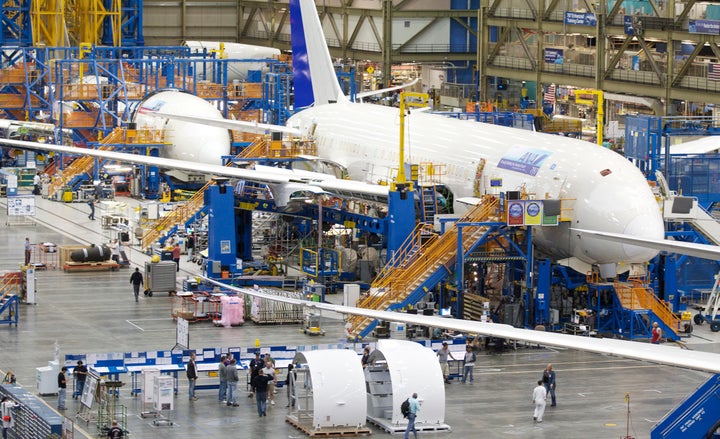The Federal Aviation Administration is investigating a Boeing engineer’s claims that the company took manufacturing shortcuts on two wide-body jets, with potentially catastrophic outcomes.
Sam Salehpour went public in a New York Times story Tuesday, describing how he believes sections of the 787 Dreamliner fuselage are improperly fastened together.
Over time, the engineer warned, stress on the joints connecting the sections could accumulate, leading to sudden midflight failure of the main body of the aircraft.
“I literally saw people jumping on the pieces of the airplane to get them to align,” he told reporters on a call Tuesday. “That’s not how you build a plane.”
The quality engineer also claimed to have seen issues with the assembly of the 777, another Boeing wide-body.
Salehpour said that the company had silenced him and transferred him to another division when he attempted to escalate his concerns ― a move that he perceived as retaliatory.
An FAA spokesperson told HuffPost that regulators are “thoroughly” looking into his complaint, which Salehpour’s lawyers submitted to the agency in January. The FAA also encouraged others to speak up.
“Voluntary reporting without fear of reprisal is a critical component in aviation safety,” the agency said. “We strongly encourage everyone in the aviation industry to share information. We thoroughly investigate all reports.”
Boeing strongly denied Salehpour’s allegations.
“These claims about the structural integrity of the 787 are inaccurate,” the company told HuffPost in an emailed statement.
“The issues raised have been subject to rigorous engineering examination under FAA oversight. This analysis has validated that these issues do not present any safety concerns and the aircraft will maintain its service life over several decades.”

A Boeing spokesperson added that the company is “fully confident in the safety and durability of the 777 family” and dismissed Salehpour’s claims of being silenced.
“We continue to monitor these issues under established regulatory protocols and encourage all employees to speak up when issues arise,” the spokesperson said. “Retaliation is strictly prohibited at Boeing.”
This comes after John Barnett, a former quality control engineer for the company, was found dead in his car last month with an apparent a self-inflicted gunshot wound. He had similarly brought a whistleblower retaliation case against Boeing.
Salehpour’s allegations are the latest dip in a turbulent period for the airplane manufacturing giant.
A different Boeing jet, the 737 Max 9, lost a door plug while in flight in January. A subsequent investigation of 737 Max 9s found loose bolts and other “installation issues” on multiple jets.
Boeing responded by ousting the head of its 737 Max program. Boeing CEO David Calhoun also said that he will step down by the end of the year.
Between 2018 and 2019, two 737 Max planes crashed and killed a combined 346 people. Investigators at the time said that faulty sensors on an automated flight-control system were to blame.
After the FAA cleared the 737 Max to fly again in 2020, Calhoun pledged that Boeing would rededicate itself to “safety, quality and integrity.”
Salehpour told reporters Tuesday that the company has so far fallen short of that goal, prompting him to speak up.
“I am doing this not because I want Boeing to fail, but because I want it to succeed and prevent crashes from happening,” Salehpour said “The truth is Boeing can’t keep going the way it is. It needs to do a little bit better, I think.”

